Bodhisattva
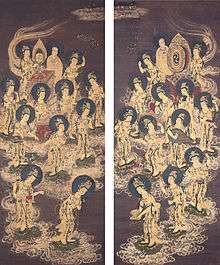
| Translations of Bodhisattva | |
|---|---|
| English | enlightenment being |
| Pali | बोधिसत्त |
| Sanskrit | बोधिसत्त्व |
| Bengali | বোধিসত্ত্ব |
| Burmese |
ဗောဓိသတ် (IPA: [bɔ́dḭθaʔ]) |
| Chinese |
菩提薩埵(菩薩), 菩提萨埵(菩萨) (Pinyin: pútísàduǒ (púsà) ) (Wade–Giles: p'u2-sa4) (Jyutping: pou4 tai4 saat3 do3)) |
| Japanese |
菩薩 (rōmaji: bosatsu) |
| Khmer |
ពោធិសត្វ (Pothisat) (UNGEGN: Pothisat) |
| Korean |
보살, 菩薩 (RR: bosal) |
| Mon |
တြုံလၟောဝ်ကျာ် ([kraoh kəmo caik]) |
| Sinhalese | බෝධි සත්ත්ව |
| Tibetan |
བྱང་ཆུབ་སེམས་དཔའ་ (byang chub sems dpa) |
| Thai |
โพธิสัตว์ phothisat |
| Vietnamese | Bồ Tát |
| Glossary of Buddhism | |
| Part of a series on |
| Buddhism |
|---|
 |
|
In Buddhism, Bodhisattva (/ˌboʊdiːˈsʌtvə/ BOH-dee-SUT-və)[1] is the Sanskrit term for anyone who has generated Bodhicitta, a spontaneous wish and compassionate mind to attain Buddhahood for the benefit of all sentient beings.[2] Bodhisattvas are a popular subject in Buddhist art.
Origins and outlines
In early Buddhism, the term bodhisattva was primarily used to refer specifically to Gautama Buddha (a contemporary of Mahavira) in his former life.[3][4] The Jataka tales, which are the stories of the Buddha's past lives, depict the various attempts of the bodhisattva to embrace qualities like self-sacrifice and morality.[4] The bodhisattva is also called a pusa. This is one who had achieved Buddhahood but chooses to remain in merciful attachment to the world. In Sanskrit this is called a Avalokitesvara.[5]
According to the Jataka tales, the term "bodhisattva" originally referred to the pre-enlightened practitioner of austerities that surpassed Śrāvakayāna and Pratyekabuddhayāna by far and completed the "Bodhisattvayāna" (Mahayāna Buddhism). Mount Potalaka, for example, is one of Bodhisattvayana. The term for practitioners who have not yet reached Bodhisattvayāna was not fixed, but the terms Śrāvaka-Bodhisattva (聲聞菩薩) and Pratyekabuddha-Bodhisattva (縁覚菩薩) had already appeared in the Āgamas of early Indian Buddhism.[6][7]
Mahayana Buddhism did not place much emphasis in honoring the Śrāvakayāna or Pratyekabuddhayāna since they were classified as part of the "Hinayana", but praise of the general Bodhisattvayāna was commonplace. Because Hinayana was disliked and the terms Śrāvaka-Bodhisattva or Pratyekabuddha-Bodhisattva were not widely used, while usage of the general term "bodhisattva" had grown in popularity. Nevertheless, "bodhisattva" retained an implied reference to someone on the path to become an arhat or pratyekabuddha. In contrast, the goal of the bodhisattva path is to achieve samyaksambodhi. [8]
Early and Theravāda Buddhism

In early Buddhism, the equivalent Pali term bodhisatta is used in the Pāli Canon to refer to Gautama Buddha in his previous lives[9] and as a young man in his current life in the period during which he was working towards his own liberation. During his discourses, to recount his experiences as a young aspirant he regularly uses the phrase "When I was an unenlightened bodhisatta..." The term therefore connotes a being who is "bound for enlightenment", in other words, a person whose aim is to become fully enlightened. In the Pāli canon, the bodhisatta is also described as someone who is still subject to birth, illness, death, sorrow, defilement, and delusion. Some of the previous lives of the Buddha as a bodhisattva are featured in the Jataka tales.
According to the Theravāda monk Bhikkhu Bodhi, the bodhisattva path is not taught in the earliest strata of Buddhist texts such as the Pali Nikayas (and their counterparts such as the Chinese Āgamas) which instead focus on the ideal of the Arahant.[10] In later Theravada literature, the term "bodhisatta" is used fairly frequently in the sense of someone on the path to liberation.[11] The later tradition of commentary also recognizes two additional types of bodhisattas: the paccekabodhisatta, who will attain Paccekabuddhahood, and the savakabodhisatta, who will attain enlightenment as a disciple of a Buddha. In the 1st-2nd century BCE Sri Lankan work, the Buddhavamsa, the idea of the person who makes a Bodhisatta vow to become a fully enlightened Buddha out of compassion for all sentient beings is presented. Another related concept outlined in the Buddhavamsa and in another text called the Cariyapitaka is the need to cultivate certain Bodhisatta perfections or paramitas
Kings of Sri Lanka were often described as bodhisattvas, starting at least as early as Sirisanghabodhi (r. 247-249), who was renowned for his compassion, took vows for the welfare of the citizens, and was regarded as a mahāsatta (Sanskrit mahāsattva), an epithet used almost exclusively in Mahayana Buddhism.[13] Many other Sri Lankan kings from the 3rd until the 15th century were also described as bodhisattvas and their royal duties were sometimes clearly associated with the practice of the Ten Pāramitās.[14]
Theravadin bhikkhu and scholar Walpola Rahula stated that the bodhisattva ideal has traditionally been held to be higher than the state of a śrāvaka not only in Mahayana but also in Theravada Buddhism. He also quotes the 10th century king of Sri Lanka, Mahinda IV (956-972 CE), who had the words inscribed "none but the bodhisattvas will become kings of a prosperous Lanka," among other examples.[15]
But the fact is that both the Theravada and the Mahayana unanimously accept the Bodhisattva ideal as the highest...Although the Theravada holds that anybody can be a Bodhisattva, it does not stipulate or insist that all must be Bodhisattva which is considered not practical.
— Walpola Rahula, Bodhisattva Ideal in Buddhism[16]
Paul Williams writes that some modern Theravada meditation masters in Thailand are popularly regarded as bodhisattvas.
Cholvijarn observes that prominent figures associated with the Self perspective in Thailand have often been famous outside scholarly circles as well, among the wider populace, as Buddhist meditation masters and sources of miracles and sacred amulets. Like perhaps some of the early Mahāyāna forest hermit monks, or the later Buddhist Tantrics, they have become people of power through their meditative achievements. They are widely revered, worshipped, and held to be arhats or (note!) bodhisattvas.[17]
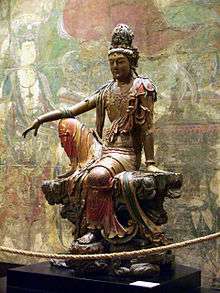
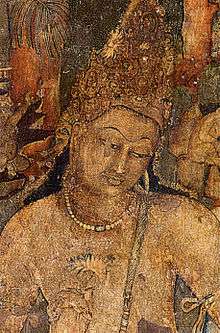
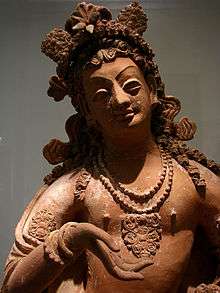
According to Jeffrey Samuels, it "may more accurately portray the differences that exist between the two yanas by referring to Mahayana Buddhism as a vehicle in which the bodhisattva ideal is more universally applied, and to Theravada Buddhism as a vehicle in which the bodhisattva ideal is reserved for and appropriated by certain exceptional people."[18]
In Mahāyāna Buddhism
Bodhisattva ideal
Mahāyāna Buddhism is based principally upon the path of a bodhisattva. According to Jan Nattier, the term Mahāyāna ("Great Vehicle") was originally even an honorary synonym for Bodhisattvayāna, or the "Bodhisattva Vehicle."[19] The Aṣṭasāhasrikā Prajñāpāramitā Sūtra contains a simple and brief definition for the term bodhisattva, which is also the earliest known Mahāyāna definition.[20][21] This definition is given as the following.[22]
Because he has enlightenment as his aim, a bodhisattva-mahāsattva is so called.
The earliest depiction of the Bodhisattva path in texts such as the Ugraparipṛcchā Sūtra describe it as an arduous, difficult monastic path suited only for the few which is nevertheless the most glorious path one can take. Three kinds of Bodhisattvas are mentioned in the early Mahayana texts: the forest, city, and monastery Bodhisattvas - with forest dwelling being promoted a superior, even necessary path in sutras such as the Ugraparipṛcchā and the Samadhiraja sutras.[23] The early Rastrapalapariprccha sutra also promotes a solitary life of meditation in the forests, far away from the distractions of the householder life. The Rastrapala is also highly critical of monks living in monasteries and in cities who are seen as not practicing meditation and morality.[24] The Ratnagunasamcayagatha also says the Bodhisattva should undertake ascetic practices (dhutanga), "wander freely without a home", practice the paramitas and train under a guru in order to perfect his meditation practice and realization of prajnaparamita.[25] These texts seem to indicate the initial Bodhisattva ideal was associated with a strict forest asceticism.
Mahāyāna Buddhism encourages everyone to become bodhisattvas and to take the bodhisattva vows. With these vows, one makes the promise to work for the complete enlightenment of all sentient beings by practicing the six perfections.[26] Indelibly entwined with the bodhisattva vow is merit transference (pariṇāmanā).
In the Lotus Sūtra, life in this world is compared to people living in a house that is on fire. People take this world as reality pursuing worldly projects and pleasures without realizing that the house is ablaze and will soon burn down (due to the inevitability of suffering). A bodhisattva is one who has a determination to free sentient beings from samsara and its cycle of death, rebirth and suffering. This type of mind is known as the mind of awakening (bodhicitta).
A commonly repeated misconception in Western literature is that bodhisattvas delay their own liberation. This confusion is based on a misreading of several different scriptural concepts and narratives. One of these is the Tibetan teaching on three types of motivation for generating bodhicitta. According to Patrul Rinpoche's 19th century Words of My Perfect Teacher (Kun bzang bla ma'i gzhal lung), a bodhisattva might be motivated in one of three ways. They are:
- King-like bodhicitta - To aspire to become a Buddha first in order to then help sentient beings.
- Boatman-like bodhicitta - To aspire to become a Buddha at the same time as other sentient beings.
- Shepherd-like bodhicitta - To aspire to become a Buddha only after all other sentient beings have done so.
These three are not types of people, but rather types of motivation. According to Patrul Rinpoche, the third quality of intention is most noble though the mode by which buddhahood actually occurs is the first; that is, it is only possible to teach others the path to enlightenment once one has attained enlightenment oneself.[27] The ritualized formulation of the bodhisattva vow also reflects this order (becoming a buddha so that one can then teach others to do the same). A bodhisattva vow ritual text attributed to Nāgārjuna, of the second-third century CE, states the vow as follows: "Just as the past tathāgata arhat samyaksambuddhas, when engaging in the behavior of a bodhisattva, generated the aspiration to unsurpassed complete enlightenment so that all beings be liberated, all beings be freed, all beings be relieved, all beings attain complete nirvana, all beings be placed in omniscient wisdom, in the same way, I whose name is so-and-so, from this time forward, generate the aspiration to unsurpassed complete enlightenment so that all beings be liberated, all beings be freed, all beings be relieved, all beings attain complete nirvana, all beings be placed in omniscient wisdom." [28]
Another reason for the misconception that a bodhisattva "delays" liberation is that a bodhisattva rejects the liberation of the śravaka and pratyekabuddha, described in Mahāyāna literature as either inferior (as in Asaṅga's fourth century Yogācārabhūmi) or nonexistent (as in the Lotus Sūtra).[29] That a bodhisattva has the option to pursue such a lesser path, but instead chooses the long path towards buddhahood is one of the five criteria for one to be considered a bodhisattva. The other four are: being human, being a man, making a vow to become a buddha in the presence of a previous buddha, and receiving a prophecy from that buddha.
The six perfections that constitute bodhisattva practice should not be confused with the actual acts of benefiting beings that the bodhisattva vows to accomplish once he or she is a buddha. The six perfections are a mental transformation and need not actually benefit anyone. This is seen in the story of Vessantara, an incarnation of Śākyamuni Buddha while he was still a bodhisattva, who commits the ultimate act of generosity by giving away his children to an evil man who mistreats them. Vessantara's actual acts do not benefit beings; in fact, he causes direct harm. However, the merit from his perfection of generosity fructifies in his lifetime as Śākyamuni Buddha when he attains complete enlightenment.[30]
Ten grounds
According to many traditions within Mahāyāna Buddhism, on the way to becoming a Buddha, a bodhisattva proceeds through ten, or sometimes fourteen, grounds or bhūmis. Below is the list of the ten bhūmis and their descriptions according to the Avataṃsaka Sūtra and The Jewel Ornament of Liberation, a treatise by Gampopa, an influential teacher of the Tibetan Kagyu school. (Other schools give slightly variant descriptions.)
Before a bodhisattva arrives at the first ground, he or she first must travel the first two of five paths:
- the path of accumulation
- the path of preparation
The ten grounds of the bodhisattva then can be grouped into the next three paths
- bhūmi 1 the path of insight
- bhūmis 2-7 the path of meditation
- bhūmis 8-10 the path of no more learning
The chapter of ten grounds in the Avataṃsaka Sūtra refers to 52 stages. The 10 grounds are:
- Great Joy: It is said that being close to enlightenment and seeing the benefit for all sentient beings, one achieves great joy, hence the name. In this bhūmi the bodhisattvas practice all perfections (pāramitās), but especially emphasizing generosity (dāna).
- Stainless: In accomplishing the second bhūmi, the bodhisattva is free from the stains of immorality, therefore, this bhūmi is named "stainless". The emphasized perfection is moral discipline (śīla).
- Luminous: The light of Dharma is said to radiate for others from the bodhisattva who accomplishes the third bhūmi. The emphasized perfection is patience (kṣānti).
- Radiant: This bhūmi it is said to be like a radiating light that fully burns that which opposes enlightenment. The emphasized perfection is vigor (vīrya).
- Very difficult to train: Bodhisattvas who attain this ground strive to help sentient beings attain maturity, and do not become emotionally involved when such beings respond negatively, both of which are difficult to do. The emphasized perfection is meditative concentration (dhyāna).
- Obviously Transcendent: By depending on the perfection of wisdom, [the bodhisattva] does not abide in either saṃsāra or nirvāṇa, so this state is "obviously transcendent". The emphasized perfection is wisdom (prajñā).
- Gone afar: Particular emphasis is on the perfection of skillful means (upāya), to help others.
- Immovable: The emphasized virtue is aspiration. This "immovable" bhūmi is where one becomes able to choose his place of rebirth.
- Good Discriminating Wisdom: The emphasized virtue is power.
- Cloud of Dharma: The emphasized virtue is the practice of primordial wisdom.
After the ten bhūmis, according to Mahāyāna Buddhism, one attains complete enlightenment and becomes a Buddha.
With the 52 stages, the Śūraṅgama Sūtra recognizes 57 stages. With the 10 grounds, various Vajrayāna schools recognize 3–10 additional grounds, mostly 6 more grounds with variant descriptions.[31][32]
A bodhisattva above the 7th ground is called a mahāsattva. Some bodhisattvas such as Samantabhadra are also said to have already attained buddhahood.[33]
School doctrines
Some sutras said a beginner would take 3–22 countless eons (mahāsaṃkhyeya kalpas) to become a buddha.[34][35][36] Pure Land Buddhism suggests buddhists go to the pure lands to practice as bodhisattvas. Tiantai, Huayan, Zen and Vajrayāna schools say they teach ways to attain buddhahood within one karmic cycle.[37][38]
Various traditions within Buddhism believe in specific bodhisattvas. Some bodhisattvas appear across traditions, but due to language barriers may be seen as separate entities. For example, Tibetan Buddhists believe in various forms of Chenrezig, who is Avalokiteśvara in Sanskrit, Guanyin in China, Gwan-eum in Korea, Quan Am in Vietnam, and Kannon in Japan. Followers of Tibetan Buddhism consider the Dalai Lamas and the Karmapas to be an emanation of Chenrezig, the Bodhisattva of Compassion.
Kṣitigarbha is another popular bodhisattva in Japan and China. He is known for aiding those who are lost. His greatest compassionate vow is:
If I do not go to the hell to help the suffering beings there, who else will go? ... if the hells are not empty I will not become a Buddha. Only when all living beings have been saved, will I attain Bodhi.
The place of a bodhisattva's earthly deeds, such as the achievement of enlightenment or the acts of Dharma, is known as a bodhimaṇḍa, and may be a site of pilgrimage. Many temples and monasteries are famous as bodhimaṇḍas. Perhaps the most famous bodhimaṇḍa of all is the Bodhi Tree under which Śākyamuṇi achieved buddhahood. In the tradition of Chinese Buddhism, there are four mountains that are regarded as bodhimaṇḍas for bodhisattvas, with each site having major monasteries and being popular for pilgrimages by both monastics and laypeople. These four bodhimandas are:
- Mount Putuo: Avalokiteśvara Bodhisattva
- Mount Emei: Samantabhadra Bodhisattva
- Mount Wutai: Mañjuśrī Bodhisattva
- Mount Jiuhua: Kṣitigarbha Bodhisattva
4 Great Bodhisattvas (in Chinese Buddhism)
四大菩薩. (菩薩 is short for菩提薩埵)
In this order: Compassion, Wisdom, Vow and Practice.
悲 智 願 行
1, Avalokitesvara Bodhisattva 觀世音 菩薩 short: 觀音 菩薩
Stands for Great Compassion.
2, Manjusri Bodhisattva 文殊師利 菩薩 short: 文殊 菩薩
Stands for Great Wisdom.
3, Ksitigarbha Bodhisattva 地藏 菩薩
Stands for Great Vow.
4, Samantabhadra Bodhisattva 普賢 菩薩
Stands for Great Practice.
Gallery
 Standing bodhisattva. Gandhāra, 2nd-3rd century.
Standing bodhisattva. Gandhāra, 2nd-3rd century. Standing bodhisattva. Gandhāra, 2nd-3rd century.
Standing bodhisattva. Gandhāra, 2nd-3rd century. Gathering of bodhisattvas. China, 6th century.
Gathering of bodhisattvas. China, 6th century.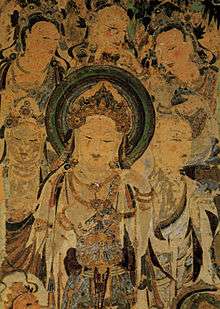 Mural of bodhisattvas. China, Tang Dynasty, 7th-9th century.
Mural of bodhisattvas. China, Tang Dynasty, 7th-9th century.
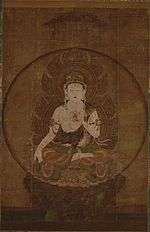 Ākāśagarbha Bodhisattva. Japan, 9th century.
Ākāśagarbha Bodhisattva. Japan, 9th century. Mural of a bodhisattva. China, 10th century.
Mural of a bodhisattva. China, 10th century..jpg) 9th century CE Srivijayan art, Chaiya, Surat Thani, Southern Thailand.
9th century CE Srivijayan art, Chaiya, Surat Thani, Southern Thailand.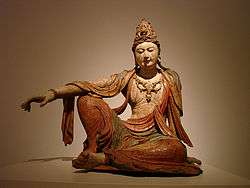 Seated Bodhisattva Avalokitesvara (Guanyin), wood and pigment, 11th century, Chinese Northern Song dynasty, St. Louis Art Museum.
Seated Bodhisattva Avalokitesvara (Guanyin), wood and pigment, 11th century, Chinese Northern Song dynasty, St. Louis Art Museum. Avalokiteśvara Bodhisattva. India, 11th-12th century.
Avalokiteśvara Bodhisattva. India, 11th-12th century.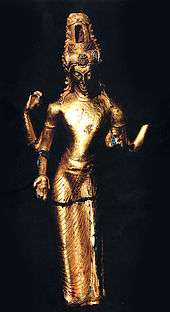 Gold coated bronze statue of Avalokitesvara in Malayu-Srivijayan style c. 11th century, Jambi, Sumatra, Indonesia.
Gold coated bronze statue of Avalokitesvara in Malayu-Srivijayan style c. 11th century, Jambi, Sumatra, Indonesia.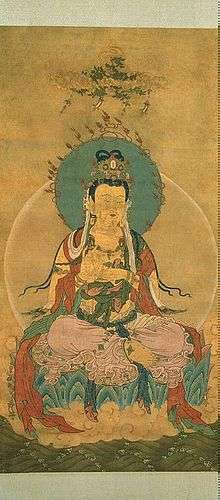 Mahāsthāmaprāpta Bodhisattva. China, 13th century.
Mahāsthāmaprāpta Bodhisattva. China, 13th century.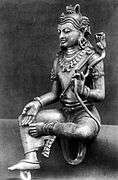 Youthful Mañjuśrī Bodhisattva silver statue. Java, 9th century Indonesia.
Youthful Mañjuśrī Bodhisattva silver statue. Java, 9th century Indonesia.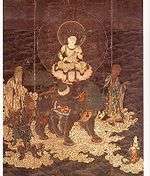 Mañjuśrī Bodhisattva crossing the sea. Japan, 14th century.
Mañjuśrī Bodhisattva crossing the sea. Japan, 14th century. Kṣitigarbha Bodhisattva. Japan, 15th century.
Kṣitigarbha Bodhisattva. Japan, 15th century. Samantabhadra Bodhisattva. Japan.
Samantabhadra Bodhisattva. Japan.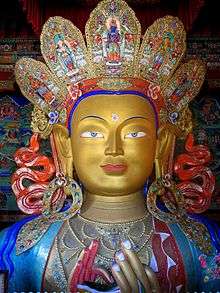 Maitreya Bodhisattva. Thiksey Monastery, Ladakh, India.
Maitreya Bodhisattva. Thiksey Monastery, Ladakh, India.- "Standing Bodhisattva" (pre-1234). Brooklyn Museum, New York City.
 Daizuigu Mahapratisara Bodhisattva. Guimet Museum.
Daizuigu Mahapratisara Bodhisattva. Guimet Museum. Shrine with an Image of a Bodhisattva. Brooklyn Museum.
Shrine with an Image of a Bodhisattva. Brooklyn Museum.
See also
- Bodhicharyavatara (A Guide to the Bodhisattva Way of Life)
- Bodhisattvas of the Earth
- Bodhisattva vows
- Buddhist holidays
- Karuna (compassion in Sanskrit)
- List of bodhisattvas
- Vegetarianism in Buddhism
Notes
- ↑ "Bodhisattva". Collins English Dictionary.
- ↑ The Bodhisattva Vow: A Practical Guide to Helping Others, page 1, Tharpa Publications (2nd. ed., 1995) ISBN 978-0-948006-50-0
- ↑ Coomaraswamy, Ananda (1975). Buddha and the Gospel of Buddhism. Boston: University Books. p. 225. LCCN 64056434.
[T]he term Bodhisattva, or Wisdom-being, first used of Gautama between the Going-forth and the attainment of Nibbāna, came to mean a Buddha-designate....
- 1 2 "bodhisattva - Buddhist ideal". Encyclopædia Britannica. Retrieved 21 August 2015.
- ↑ Feuchtwang, Stephan (2016). Religions in the Modern World (3rd ed.). Routledge. p. 154.
- ↑ 聲聞菩薩 (Śrāvaka-Bodhisattva). 阿含部 (Āgama); Text Database of Taishō Tripiṭaka. (accessed: January 15, 2016)
- ↑ 縁覚菩薩 (Pratyekabuddha-Bodhisattva). 阿含部 (Āgama); Text Database of Taishō Tripiṭaka. (accessed: January 15, 2016)
- ↑ Gethin, Rupert (1998). The foundations of Buddhism (1. publ. paperback ed.). Oxford [England]: Oxford University Press. pp. 224–234. ISBN 0-19-289223-1.
- ↑ Basham, A.L. (1981). The evolution of the concept of the bodhisattva. In: Leslie S Kawamura, The Bodhisattva doctrine in Buddhism, Published for the Canadian Corporation for Studies in Religion by Wilfred Laurier University Press, p.19
- ↑ "Arahants, Bodhisattvas and Buddhas".
- ↑ 南傳菩薩道(上) Archived April 10, 2008, at the Wayback Machine.
- ↑ "The crossroads of Asia", edited by Ellizabeth Errington and Joe Cribb, The ancient India and Iran Trust, 1992, ISBN 0951839918, p.189-190
- ↑ Holt, John. Buddha in the Crown : Avalokitesvara in the Buddhist Traditions of Sri Lanka. 1991. p. 59
- ↑ Holt, John. Buddha in the Crown : Avalokitesvara in the Buddhist Traditions of Sri Lanka. 1991. pp. 59-60
- ↑ Holt, John. Buddha in the Crown : Avalokitesvara in the Buddhist Traditions of Sri Lanka. 1991. p. 60
- ↑ Rahula, Walpola. "Bodhisattva Ideal in Buddhism (from Gems of Buddhist Wisdom)". Buddhist Missionary Society, 1996.
- ↑ Williams, Paul. Mahāyāna Buddhism: The Doctrinal Foundations. Taylor & Francis, 1989, page 328.
- ↑ Samuels, J. THE BODHISATTVA IDEAL IN THERAVAADA, BUDDHIST THEORY AND PRACTICE: A REEVALUATION OF THE BODHISATTVA-`SRAAVAKA OPPOSITION; Philosophy East and West Volume 47, Number 3 July 1997 P.399-415 (C) by University of Hawai'i Press
- ↑ Nattier, Jan (2003), A few good men: the Bodhisattva path according to the Inquiry of Ugra: p. 174
- ↑ Mall, Linnart. Studies in the Astasahasrika Prajnaparamita and Other Essays. Motilal Banarsidass. 2005. pp. 53-54.
- ↑ Hirakawa, Akira. A history of Indian Buddhism: from Śākyamuni to Early Mahāyāna. Motilal Banarsidass. 2007. p. 297.
- ↑ Conze, Edward. The Perfection of Wisdom in Eight Thousand Lines and its Verse Summary. Grey Fox Press. 2001. p. 89.
- ↑ Ray, Reginald. Buddhist saints in India, page 252.
- ↑ Ray, Reginald. Buddhist saints in India, page 265.
- ↑ Ray, Reginald. Buddhist saints in India, page 255.
- ↑ The Bodhisattva Vow: A Practical Guide to Helping Others, pages 4-12, Tharpa Publications (2nd. ed., 1995) ISBN 978-0-948006-50-0
- ↑ Words of My Perfect Teacher: A Complete Translation of A Classic Introduction to Tibetan Buddhism. Translated by The Padmakara Translation Group. (Walnut Creek: Altamira, 1994), 218.
- ↑ Nagārjuna. Byang chub mchog tu sems bskyed pa'i cho ga (Bodhicittotpadaviddhi, Ritual for Generating the Intention for Supreme Buddhahood). Toh. 3966 Tengyur, mdo, gi. (sems can thams cad bsgral ba dang/ sems can thams cad dgrol ba dang/ sems can thams cad dbugs dbyung ba dang/ sems can thams cad yongs su mya ngan las 'da' ba dang/ sems can thams cad thams cad mkhyen pa'i ye shes la dgod pa'i slad du ci ltar bla na med pa yang dag par rdzogs pa'i byang chub tu thugs bskyed pa de bzhin du bdag ming 'di zhes bgyi ba yang dus 'di nas bzung)
- ↑ "bodhisattva" In The Princeton Dictionary of Buddhism (Princeton: Princeton University Press, 2013), 135.
- ↑ "Vessantara" In The Princeton Dictionary of Buddhism (Princeton: Princeton University Press, 2013), 965.
- ↑ "ԲϢ - Ŀ ļ". Archived from the original on 8 September 2015. Retrieved 21 August 2015.
- ↑ 鄔金旺度. "吉祥鄔金密嚴寺". Retrieved 21 August 2015.
- ↑ 459 因地菩薩和果地菩薩
- ↑ 三大阿僧祇劫 Archived November 21, 2008, at the Wayback Machine.
- ↑ 成佛的目的是到每一個世界去度眾生. Archived April 11, 2009, at the Wayback Machine.
- ↑ 即身成就與三大阿僧祇劫之修行 Archived May 26, 2013, at the Wayback Machine.
- ↑ "顯教與密教". Retrieved 21 August 2015.
- ↑ 「無諍之辯」導讀
References
- Analayo, The Genesis of the Bodhisattva Ideal, Hamburg Buddhist Studies 1, Hamburg University Press 2010
- Gampopa; The Jewel Ornament of Liberation; Snow Lion Publications; ISBN 1-55939-092-1
- White, Kenneth R.; The Role of Bodhicitta in Buddhist Enlightenment: Including a Translation into English of Bodhicitta-sastra, Benkemmitsu-nikyoron, and Sammaya-kaijo; The Edwin Mellen Press, 2005; ISBN 0-7734-5985-5
- Lampert, K.; Traditions of Compassion: From Religious Duty to Social Activism. Palgrave-Macmillan; ISBN 1-4039-8527-8
- Gyatso, Geshe Kelsang Gyatso, The Bodhisattva Vow: A Practical Guide to Helping Others, Tharpa Publications (2nd. ed., 1995) ISBN 978-0-948006-50-0
- Shantideva: Guide to the Bodhisattva's Way of Life: How to Enjoy a Life of Great Meaning and Altruism, a translation of Shantideva's Bodhisattvacharyavatara with Neil Elliott, Tharpa Publications (2002) ISBN 978-0-948006-88-3
- The Making of a Savior Bodhisattva: Dizang in Medieval China, by Zhiru (Kuroda Institute Studies in East Asian Buddhism series no. 21), University of Hawaii Press, 2007; ISBN 978-0-8248-3045-8 at Google Books
External links
| Wikimedia Commons has media related to Bodhisattva. |
- The Ethical Discipline of Bodhisattvas, by Geshe Sonam Rinchen (Tibetan Gelug Tradition)
- Bodhisattva, probably Avalokiteshvara (Guanyin), Northern Qi dynasty, c. 550--60, video, Smarthistory.
- The 37 Practices of Bodhisattvas online with commentaries.
- The Thirty-Seven Practices of Bodhisattvas, all-in-one page with memory aids & collection of different versions.
- Audio recitation of 'The 37 Practices of Bodhisattvas' in MP3 format (Paul & Lee voices).
- What A Bodhisattva Does: Thirty-Seven Practices by Ngulchu Thogme with slide show format.
- Access to Insight Library: Bodhi's Wheel409
- Arahants, Buddhas and Bodhisattvas by Bhikkhu Bodhi
- The Bodhisattva Ideal in Theravāda Theory and Practice by Jeffrey Samuels
- Online exhibition analyzing a Korean Bodhisattva sculpture
- Buddhanet.net Ksitigarbha Bodhisattva
- Sacred visions : early paintings from central Tibet, fully digitized text from The Metropolitan Museum of Art libraries